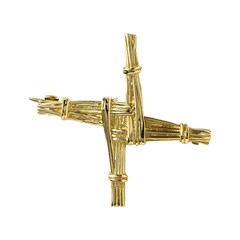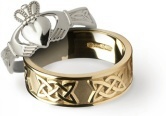Saint Brigid's Cross
 |
The Saint Brigid’s cross is a custom that marks the feast day of St. Brigid, which falls on the 1st of February, the beginning of spring. The making of the cross has many meanings and stories; one ritual is that the cross is hung over the door as a way of protecting the household from evil spirits and energies. Another tradition that is practiced is that a new cross is made each year on St. Brigid's day, and the old one hanging from the year before is then burned to keep fire from the household.
Christian Origins
The story of St. Brigid and her cross derives from a tale about how she wove the form of a cross from the rushes on the floor of a pagan chieftain, who she was trying to convert to Christianity on his deathbed. And upon hearing the significance of the cross and the story of Jesus asked to be baptized immediately.
The Original Story
An old pagan chieftain thought to have been from Kildare was on his deathbed. Brigid was sent for by some Christians in his household to preach to him about Christ. She arrived and the chieftain was delirious from fever and the possibility of converting him seemed doubtful. Brigid sat with him and comforted him. At this time it was common for the dirt floor to be strewn with rushes for warmth and cleanliness. Brigid gathered a few rushes and began to weave them into a cross tying the ends together. The chieftain asked what she was doing and so she began telling him about the cross and story of Christ. His delirium from the sickness quieted and he questioned her with a growing curiosity. By teaching from the cross he was converted and baptized before he died. And since then the cross of rushes has been associated with the saint.
Although thought of as Christian the St. Brigid cross may have Pagan origins. The saint's feast day falls on the pagan Gaelic holiday of Imbolc marking the beginning of spring. It is one on the four main seasonal festivals that takes place at the half way point between the winter solstice and the spring equinox. Imbolc originally celebrated the goddess Brigid; Brigid was the Goddess of inspiration and healing. It is thought that the link between the festival and Brigid is in her role as a fertility goddess. Making the cross from rushes is thought to have derived from a pagan symbol of significance thats meaning has been lost but may have been understood in rural areas up until the 20th century. The only remaining element of the tradition of today’s Brigid’s cross is that it is said to protect a household from fire. This does not fit in with the Christian story of the cross, so it is likely an older pagan tradition is the source of the custom.
Making a St. Brigid’s Cross
Traditionally made from rushes that are pulled instead of cut, the cross is produced by weaving at least 12 -16 reeds of the rushes from a center point in a criss-cross fashion to create the cross shape. This is repeated until the cross is sturdy and thick. It is then tied with string at each end and cut to make it even and sprinkled with holy water.
